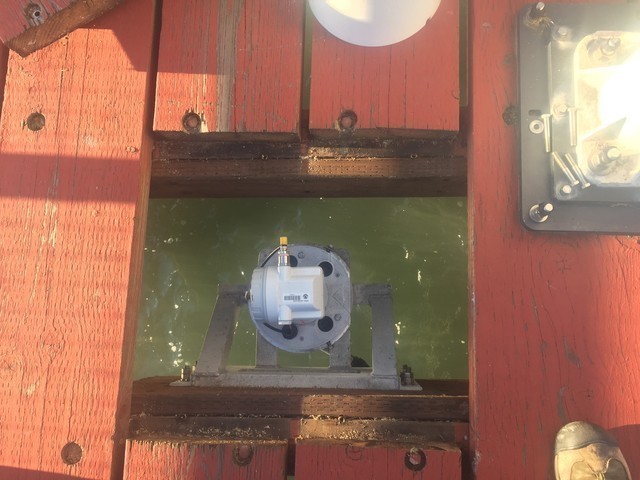In the left column of the daily pages in your tide book, you’ll see the phases of the Moon, and in the columns to the right of a full and new Moon, you’ll see that some of the heights are in bold, since they are higher than average and called “spring” tides. When the Sun and Moon and Earth are aligned in either a new or full Moon, the gravities of the first two can be thought of as additive, and spring tides result. When the Moon is perpendicular to a line between Earth and Sun at a waning half-Moon (the left side is bright), or waxing half-Moon (the right side is bright), we have “neap” tides, which are lower than average.
Tidal heights are measured relative to a refence sea level or tidal “datum,” which is mean lower low water. This datum is determined by empirical observation of the tides over a period of nineteen years at, for example, Tide Station Golden Gate, the oldest continually operating tide station in the western hemisphere. This is called a tidal epoch.
Golden Gate tidal gauge
But why nineteen years? This video shows some of the complications of the Moon’s orbit. It’s an ellipse and is tilted approximately 5° to the plane of the ecliptic, while the Earth itself is tilted 23.5°. In addition, the line of the apsides, which is the line between the Moon’s perigee (closest point) and apogee (farthest point), rotates around the Earth in a period of 8.85 years, which is called the “precession of the apsides.” The plane of the orbit also wobbles, like a plate settling on a table, in a retrograde direction every 18.6 years. This is called the “regression of the nodes.” These variations in the Moon’s orbit change the Moon’s effect on tides, which is why NOAA uses a “mean” or average height of tide over nineteen years to enable a steady reference. (The Greeks noticed a similar but not directly related period of the Moon’s orbit, discovered by Athenian Meton in the 5th century BC, and so called the Metonic cycle. Babylonians, Polynesians, and native Americans observed this, too.)
The Earth’s seasons occur because although the Earth’s tilt doesn’t change as it orbits (or only over a period of 26,000 years, which we can ignore), it either tilts at 23.5° towards the Sun in northern hemisphere summer, or away from it in northern hemisphere winter, and this affects the amount of gravity the Sun directly exerts in different parts of the globe. The Earth’s orbit around the Sun is also an ellipse and has similar precessions as the Moon, but in addition is affected by the gravity of the planets. The speed of both the Moon and Earth vary throughout their orbits, as was discovered by Kepler.
There are even more variables to the relationship between Earth, Moon, and Sun, and tides, and if this is starting to get a bit dizzying, don’t feel bad. No less an authority than Sir Isaac Newton said that contemplating the Moon’s orbit gave him a headache. Writing a century before Newton, Galileo did not believe the Moon could affect the tides at all, despite centuries of mariners noticing the conjunction of tides and phases of the Moon. This was because, like Einstein with regard to quantum entanglement, the idea that a distant object could affect the Earth struck him as something akin to witchcraft. To be fair to Galileo, even though we understand what gravity does, we still don’t understand what it is. But tell you what, let’s leave that one alone.
Here is a fun fact that is the result of relationships between orbit of the Earth and Moon: When you see a waning half-Moon, the Earth will be where the Moon is in about three and a half hours—but it will be gone, so don’t worry. Here’s why: The orbit of the Earth is an ellipse, but let’s not be fancy and call the distance to the Sun from Earth about 93 million miles. The diameter of the Earth’s orbit is double that, or 186 million miles, and multiplying by pi we get the circumference, which is 584,040,000 miles. The year takes 365 days, so dividing by 365 we get 1,600,109 miles per day, and dividing that by 24 we see that the speed of the Earth around the Sun is 66,671 miles per hour. Average Earth-Moon distance is 238,900 miles. The Moon orbits the Earth counterclockwise, in the same direction that the Earth orbits the Sun, and when it is ahead of the Earth in the earth’s orbital path, you’ll see the left half illuminated. It will be visible from about midnight to noon. We divide the Moon’s distance by the speed of the Earth, and get approximately three and a half hours to get to the moon’s location at the earth’s speed.
We’ve just scratched the surface of all the things affecting tides. For example, on a new Moon when both Sun and Moon are on the same side of the Earth, why do we still have two tides, instead of one big one? Why, under the same Moon and Sun, does the Bay of Fundy have tides of over fifty feet while Tahiti has about one? What is a seiche? The boffins at NOAA’s National Ocean Service earn their pay by figuring this stuff out in intricate detail. If questions like this intrigue you but you aren’t fond of knotty math, check out Beyond the Moon.


